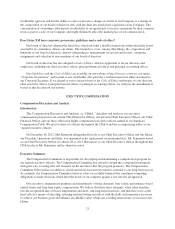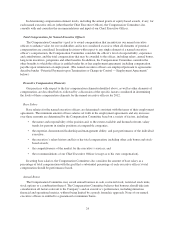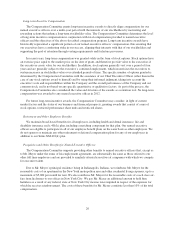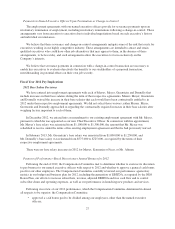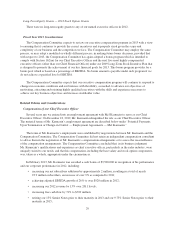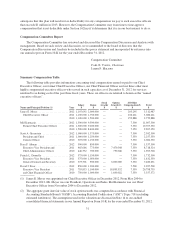XM Radio 2012 Annual Report Download - page 33
Download and view the complete annual report
Please find page 33 of the 2012 XM Radio annual report below. You can navigate through the pages in the report by either clicking on the pages listed below, or by using the keyword search tool below to find specific information within the annual report.Overall Program Objectives and Processes
Program Objectives
We strive to attract, motivate and retain highly qualified executives with the skills and experience necessary
to achieve our key business goals and enhance stockholder value by providing total compensation that is largely
performance-based and competitive with the various markets and industries in which we compete for talent. We
strive to provide incentives to align the interests of our executives with those of our stockholders and deliver
levels of compensation that we believe are commensurate with performance.
We achieve these objectives through three primary compensation elements:
• a base salary;
• a performance-based discretionary annual bonus that constitutes the short-term incentive element of
our program; and
• equity-based awards that constitute the long-term incentive element of our program.
The Compensation Committee believes that a program comprised principally of the above-described three
elements is consistent with programs adopted by companies with which we compete for executive talent. The
program is structured to meet the requirements of the competitive environment in which we operate, while
ensuring that named executive officers are compensated in a manner that advances both the short- and long-term
interests of our stockholders and avoids unnecessary or excessive risk-taking.
The Compensation Committee believes that delivering compensation in the form of, or based on the value
of, our common stock promotes alignment between executive performance and stockholder interests.
Accordingly, the value of equity-based compensation represents a large portion of our executives’ total
compensation, including through grants of equity-based awards. A high proportion of the compensation for our
named executives officers also involves pay that is “at risk” — namely, the discretionary annual bonus and
equity-based awards. The Compensation Committee uses “at risk” compensation to motivate the named
executive officers to achieve goals and objectives that support our business plan and align our executives’
interests with those of our stockholders.
Processes and Compensation Decisions
The Compensation Committee regularly reviews our compensation practices to assess whether our existing
compensation structure properly increases stockholder value. In 2011, the Compensation Committee engaged
Exequity LLP, an independent compensation consulting firm, to assist it in designing a bonus program that
would qualify for the performance-based exception contained in Section 162(m) of the Internal Revenue Code.
After consultation with Exequity, this bonus program was again adopted by the Compensation Committee in
2012. Exequity did not provide advice to the Compensation Committee on other compensation-related decisions
for 2012. Instead, the members of the Compensation Committee relied on their significant experience, general
industry knowledge and informed judgment in making compensation decisions as to our named executive
officers’ base salaries and annual bonuses.
The Compensation Committee does not attempt to set compensation levels for each named executive officer
within a particular range related to levels provided by peers. The Compensation Committee relies on the general
business and industry knowledge and experience of its members and occasionally uses informal market
comparisons as one of many factors in making compensation decisions. Other factors considered when making
individual executive compensation decisions include individual contribution and performance, reporting structure,
historical compensation, internal pay equity, complexity and importance of roles and responsibilities, expected
future contributions, leadership and growth potential, and our performance. The Compensation Committee also
believes that it is in our stockholders’ interests, and consistent with industry practice, to enter into employment
agreements with our named executive officers in order to provide stability for our senior executives.
23










